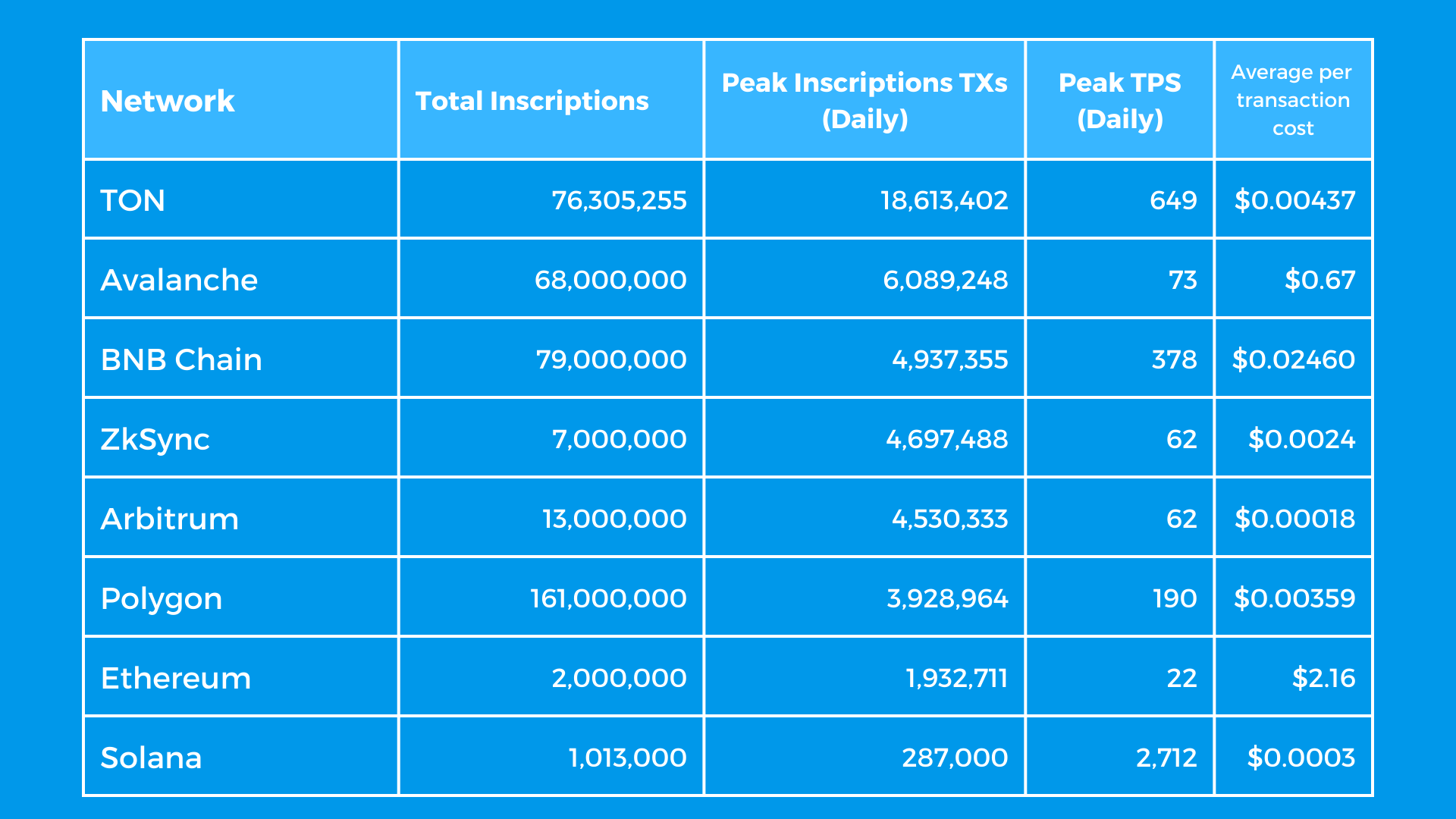Inscriptions on TON: New Crypto Craze or Next-Gen Tokens?

In what has been a groundbreaking few weeks for the TON Ecosystem, inscriptions have launched and caused all kinds of activity on The Open Network. Since the first inscriptions protocol was launched on TON, there have been 83 million transactions, 105,000 new unique users, 2,525 new inscriptions tokens launched, and TON has collected over 170,000 TON in transaction fees[1].
Before inscriptions, TON's average daily transactions were around 50k, and total transactions on the network were just 198 million. Since December 5, the activity has grown to an average of 1.5 million daily transactions and sent total transactions to 274 million. That's almost 40% transaction volume growth in just 15 days.
This seems to be only the beginning, as more inscription protocols are planned to launch on TON in the coming weeks. With Tonano and ShardZone already launched, and Gram20 launching right now.
So, what are Inscriptions? Why are they surging in popularity across all blockchains? Why have they come to TON? What can we do with them? Are they just crypto's latest craze or the next generation of tokens? We'll answer all that and more in this blog article.
What are inscriptions?
Inscriptions began on the Bitcoin blockchain with the development of the Ordinals protocol by software engineer Casey Rodarmor. This protocol was designed to inscribe data directly onto individual satoshis, the smallest unit of Bitcoin. By leveraging the available data space in Bitcoin transactions, Ordinals allow for embedding various data types, such as images or text, thereby creating distinct, identifiable units within the blockchain. This innovative approach enabled the creation of unique digital assets on a blockchain not initially designed for such complex functionalities.
Over the last six months, however, the popularity of many BRC-20 tokens has led to the spread of BRC20-style tokens to blockchains beyond Bitcoin. These tokens, which originated as a workaround on Bitcoin due to its lack of native token support, are now being adopted on other blockchains that already have native support for token creation.
When these token standards are applied to other blockchains, they are often renamed to reflect their specific chains, such as PRC-20 on Polygon PoS, Ethscriptions on Ethereum, Doginals on Dogecoin, and Solana Inscriptions on Solana. This expansion to other blockchains has significantly increased network activity across ALL chains. Now, they have come to TON, where it's so early that there is no official standard.
What are the challenges with Inscriptions?
The increased blockchain activity caused by inscriptions has been a major issue for many blockchains, most notably Bitcoin, where core developers are split on whether the development should be considered spam and banned or innovation and be supported.
With Bitcoin and most chains, the issue is blockchain fees go up due to the increased demand for transactions. With Bitcoin, ETHscriptions, and Avalanche, this renders the blockchain almost unusable at points due to the already high costs of transactions.
With other chains like TON, Arbitrum, and ZkSync, some of the infrastructure connected to the blockchains initially had issues dealing with processing transactions when inscriptions were launched due to the sudden increased load. In the worst case with Arbitrum, that caused a complete temporary network halt.
TON also experienced growing pains as many network validators needed to account for the sudden growth in normal transaction volumes. This caused bandwidth limits to be reached, leading to congestion on the network as transactions were waiting to be confirmed. The TON Core Development Team acted swiftly, working with the network validators worldwide to unblock the transaction queue. These swift upgrades helped the inscriptions launch to continue without an issue.
Why have Inscriptions surged in popularity?
Despite the challenges, Inscriptions are surging across all chains for a few reasons:
- Novelty: These tokens represent a new and innovative way to use blockchain technology, offering a unique token creation and management approach.
- Lower Transaction Costs: Inscription-based tokens are cheaper than tokens built using smart contracts on other blockchains.
- Ease of creation: Creating these tokens is more accessible to a wider range of people, somewhat similar to the concept of proof-of-work mining.
- Speculative Appeal: Like many cryptocurrency trends, there is a speculative element where investors are attracted to the potential for rapid value appreciation.
Why are Inscriptions coming to TON?
Inscriptions have shown their potential to the blockchain community, with successful launches across many major chains. However, they need a particular type of high-performing blockchain to succeed because of the issues they have caused with transaction fees and network congestion.
Firstly, TON is a highly performant blockchain; as we saw in the World's Fastest Blockchain Record attempt, TON can hit up to 104,715 Transactions per second. This event didn't use the mainnet to avoid major disruptions to users in the event of failure; it used a testnet and a future upgrade of the TON Protocol, called the "Accelerator Upgrade." That being said, the world saw what TON was capable of with regard to scalability. This has been proven further on the Mainnet for the first time, reaching the 200 millionth transaction 15 days ago, and now on track to hit the 300 millionth in just 30 days.
Secondly, TON has a fixed fee structure where fees remain stable no matter the load on the network. While TON was under peak load since inscriptions launched, fees have averaged a tiny $0.004 per transaction.
Thirdly, TON has a unique integration into Telegram, enabling mini-apps built within Telegram to connect and use the TON blockchain. This gives TON projects a unique distribution channel. All 800 million Telegram users can easily access a TON wallet, buy TON, and make a TON-based transaction without ever leaving their daily messenger. This increases the reach of TON projects while massively improving the onboarding and end-user experience.

What are the use cases for Inscriptions?
Inscriptions are effectively unique tokens, so they have similar use cases to normal tokens based on smart contracts.
The two major uses for Inscriptions are:
-
Fair Token Launch: What is unique about inscriptions is the “Minting” process, unlike regular smart contract tokens, where the token creator controls the token distribution. Inscriptions are initially minted by the user in various quantities, and users only pay whatever the transaction fee is to mint. It means tokens are fairly distributed as users need to devote time and effort to mint a new Inscriptions token, and no user has an advantage over another in minting. This fair launch mechanism for token distribution could become a new standard for how projects initially launch their token.
-
Collectibles or NFTs: Inscriptions can also be used as NFTs because unique data like images and text can be attached to individual units of a cryptocurrency. This creates a distinct and immutable record on the blockchain and could provide a new avenue for digital art and media to be stored, authenticated, and traded.

